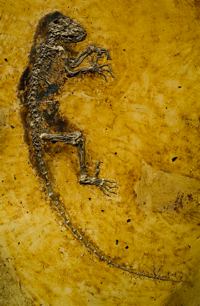
- Darwinius masillae, aka “Ida.” From Wikipedia
Last week, Inside Higher Ed reported the launch of Futurity.org, a new website intended to provide a direct outlet for research universities to announce science news. It’s led by Duke, Stanford, and U. Rochester, and the 35 participating universities include some pretty big names.
Earlier this summer, ESN reader and commenter Dave Snoke sent us a couple of links and some good questions that, unfortunately, we weren’t able to get to until now. Dave was remarking upon this year’s big fossil story, “Ida,” which, while an important discovery by any measure, became the subject of an orchestrated media push billing the fossil as “the missing link.” To put it mildly, Ida failed to live up to the hype. Many science writers criticized the media circus, which was designed to sell books and raise interest in a television documentary. Dave sent us links to the two most important critiques, from Nature and Science.
From Science:
Many of the leading scientists who study primate evolution don’t think Ida lives up to Hurum’s billing as a human ancestor; most think she’s a relative of lemurs instead. After looking at photos and a description that Hurum and his collaborators published in an online paper last week, most researchers think the skeleton—though stunning—reveals little new information about ancient primates, much less human origins. Some worry that the publicity framing Ida as a human ancestor will backfire as her true identity and lowly origins are revealed. “A lot of articles say it is a missing link. That is wrong,” says paleoanthropologist Elwyn Simons of Duke University in Durham, North Carolina. “It has no convincing links to monkeys, apes, and humans.”
Nature‘s editorial concludes:
In principle, there is no reason why science should not be accompanied by highly proactive publicity machines. But in practice, such arrangements introduce conflicting incentives that can all too easily undermine the process of the assessment and communication of science.
Dave asks a couple of very good questions. First, regarding the ethics of public relations:
1) I have been involved with press releases to the media, and invariably the story gets mangled. Some of this is not the scientist’s fault. But in the stories below it seems clear that the scientists wanted the PR. They paid big bucks ($750K) for the fossil, with an aim to movie rights. Recently CERN in Geneva was also happily involved in promoting the Angels and Demons movie. What should be our ethic in regard to PR “opportunities”?
Second, about how this kind of hype surrounding scientific discoveries affects the public’s perception of science:
2) Is it any wonder that the public views scientific claims (especially in the area of evolution) with suspicion when they see stories like this? Does making claims like this, which so often are eventually refuted or retracted, help the case for evolution, or would it be better to present a story of careful weighing of pros and cons? In the public arena, evolutionists have worked hard to suppress any attempts to introduce “weighing of evidence for an against evolution” in school curriculums. The argument is that allowing arguments against evidence for evolution would promote an “anti-science” attitude which would hurt science education. Or is the “selling” of science theories actually hurting science more than a presentation of careful weighing of facts would?
So, what do you think? (Please note that the question isn’t whether evolution is true or whether this fossil proves or disproves evolution. Dave is asking, do overhyped stories like this one help, or hurt, the cause of evolution proponents? A similar question could be asked about the way health findings are promoted in the media.)
The former Associate Director for the Emerging Scholars Network, Micheal lives in Cincinnati with his wife and three children and works as a web manager for a national storage and organization company. He writes about work, vocation, and finding meaning in what you do at No Small Actors.

Thanks for the work on my post.
I am not only asking whether “hype” hurts the cause of evolution and other science areas. I am also asking whether the deliberate suppression of works that question evolution hurts the cause of science and evolution. I have seen ID papers that were quite reasonable that question basic claims of common descent. Yet there seems to be a feeling that scientists must present a front that all such claims are not to be taken seriously, that they are “just religion.”